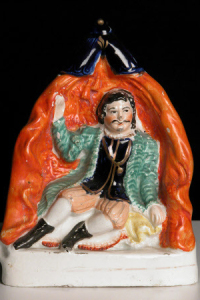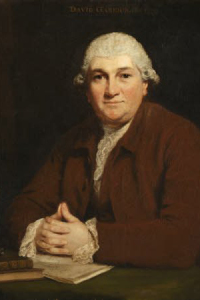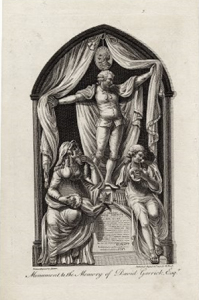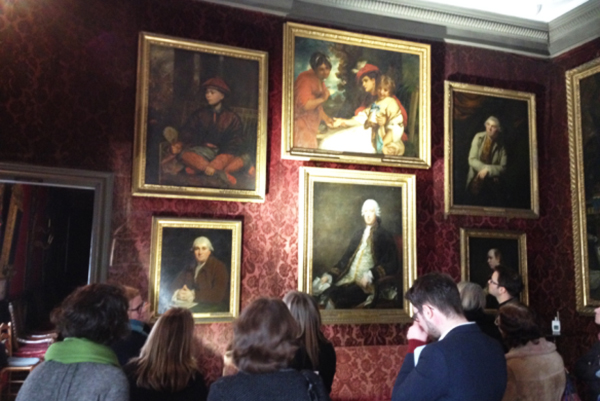From 2011 to 2013, Royal Oak supporters raised $1.25 million to support the conservation of Knole’s ballroom and its contents. Knole is one of the Trust’s most spectacular properties – it’s a sprawling estate with hundreds of rooms, its own deer park and a profound history tied to some of England’s most important cultural figures. We are proud to help protect such a special place forever, for everyone.
The preservation work at Knole is ongoing, and the hardworking team at its conservation studio is maintaining a fascinating blog about their progress. We’ll be sharing some of their posts in the weeks and months to come, including this one. Stay tuned for more!
By The Knole Conservation Studio
Our newest entry in our favourite objects series comes from our newest team member. Alice started as a volunteer at Knole back in May 2014 before coming on as a permanent member of staff. With some tough choices to make Alice has selected the painting of David Garrick by Joshua Reynolds as her favourite object.

Ceramic, Staffordshire, David Garrick (1717-1779) as Richard III in William Shakespeare’s ‘Richard III’, Staffordshire Pottery. Full-length Staffordshire figure of David Garrick as Richard III, sitting on a couch in a tent, wearing a green coat, black doublet, pink breeches and black boots.
Choosing a favorite object was a tough decision; out of Knole’s vast array of fascinating and magnificent treasures, how do you pick just one? But after a lot of thought, I’ve decided to go with one of the paintings in our collection. It’s a portrait of the 18th century actor, playwright and theatre manager David Garrick, painted in 1776 by the renowned artist Joshua Reynolds. It normally hangs in the Reynolds room, along with 8 other examples of the artist’s work.
Reynolds paints Garrick sitting at a table covered in a green cloth. He is shown composing a prologue to be delivered at the start of a performance; his clasped hands rest on a piece of paper and if you look to the left of the painting you can see a quill pen and bottle of ink. In the foreground is a carefully arranged pile of books. Garrick himself wears a plain brown coat, with elaborate white lace poking out at his cuffs and collar and a powdered wig perched on his head. He smiles out of us, his dark brown eyes twinkling. It’s this smile which makes this my favourite object. He looks so genial, warm and welcoming. When I see this painting, it always makes me smile.

Oil painting on canvas, David Garrick (1717-1779) `The Prologue Portrait¿ by Sir Joshua Reynolds (Plympton 1723 – London 1792), circa 1776.A half-length portrait, turned slightly to the left, gazing at the spectator seated at a table on which are quill, books and folio entitled Prologue, his hands clasped and his thumbs pressed together,, wearing a brown coat, white lace stock and cuffs, and powdered wig. Not the pentimenti in the rendition of the painted thumb.
But I’m also fascinated by the man himself. Garrick was the most painted person of his age, after the King, and this portrait is one of over 250 different representations of him. He was a superstar of the 18th century, an actor who wowed audiences and critics alike and dominated the London stage for over 30 years. But Garrick was more than just the greatest actor of his time. He was also the man who revolutionised almost every aspect of the English theatre.
Born in 1717, Garrick travelled to London in 1737, with his teacher Samuel Johnson (who would later achieve fame as the writer of the dictionary). Garrick may only have been 5”4, but he was to make a big impression. When he made his debut as Richard III at Goodman’s Fields Theatre in East London, he was an overnight sensation. Garrick’s performance was unlike anything the London audiences had seen before. In the 18thcentury, a formal, rather bombastic style of acting dominated the stage, where the actors would proclaim their lines and use standardised gestures to demonstrate emotion. When Garrick performed, he gave his characters real emotion, using a more natural, realistic style that quickly took the London stage by storm. Garrick wasn’t above using a little gimmickry; during his a performance of Macbeth, for example, he had a wig that made his hair literally stand on end. But his radical, innovative approach changed acting forever.

An engraving of Garrick’s monument in Westminster Abbey. Picture from the Folger Shakespeare Library.
Garrick didn’t stop there. When he became the joint manager of the Theatre Royal in 1747 (aged just 30), he immediately set about introducing sweeping changes. Going to see a play 300 years ago was very different to today. It was an opportunity to meet and socialise with friends, flirt and show off. Interrupting the action and barracking the actors all part of the experience. People could pay extra to sit on the stage, up close to the action and in full view of everyone else in the theatre. Alternatively, if you wanted to be entertained but didn’t want to sit through the whole play, you could pay a cheaper price to be admitted half way through. Garrick stopped all that, switching the focus to the play and players. He also changed the look of the plays, making sure that the scenery, costumes and lighting effects were used more effectively so that they made sense with the characters and action. Whereas before the actors often had little training or preparation, Garrick subjected his actors to new and intensive rehearsal techniques. Garrick made the theatre professional and acting a profession. He is written into the DNA of the theatre we know today.
However, there is also an element of sadness to this painting. It was painted in 1776, the year of Garrick’s last appearance on the stage. He died at his home three years later, aged 61. His funeral procession, one of the greatest ever seen, stretched from the Strand to Westminster Abbey. He was buried in Poet’s Corner, the first actor to be granted the honour.
I mentioned that this painting of Garrick normally hangs in the Reynolds Room. At the moment it is currently in storage as Knole becomes the focus of a landmark project. The largest project within the Trust today, this £19.8 million renovation programme will take over 5 years to complete. Contractors are currently working in the second half of the house, from the Reynolds Room to the Cartoon Gallery, meaning that all the objects in these rooms that can be removed have been put into storage for their protection. The work is to repair and conserve, safeguarding the building and collections and installing special conservation heating and lighting. This is to ensure that David Garrick, along with the rest of Knole’s magnificent collection, can be enjoyed for generations to come.




